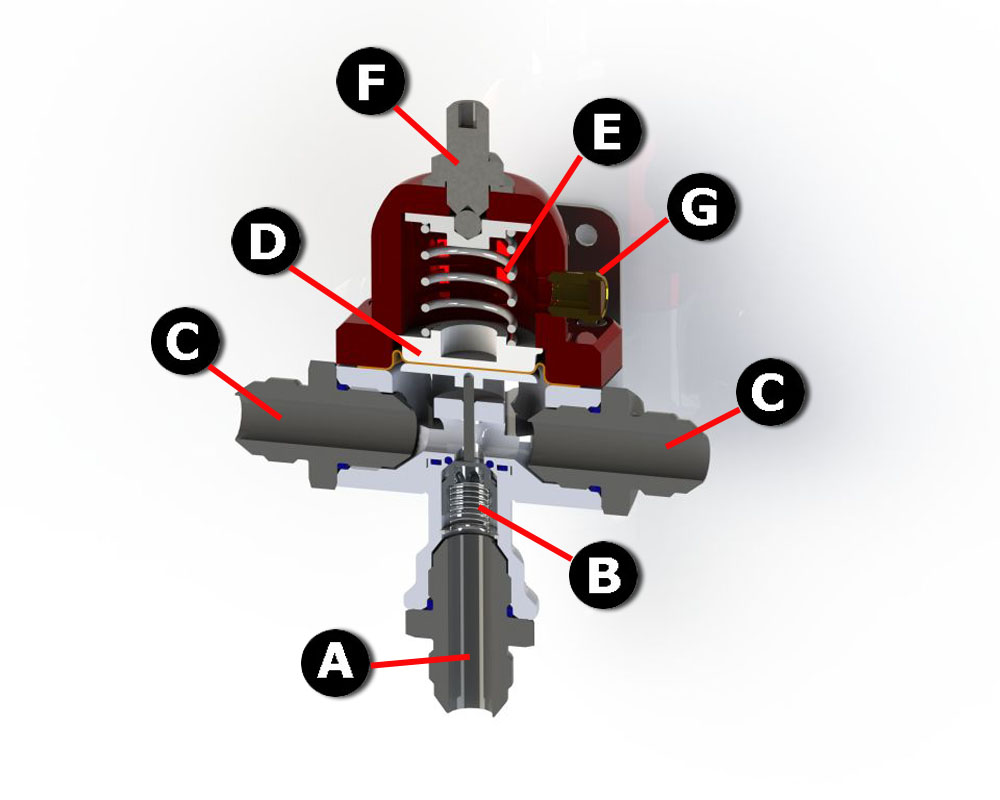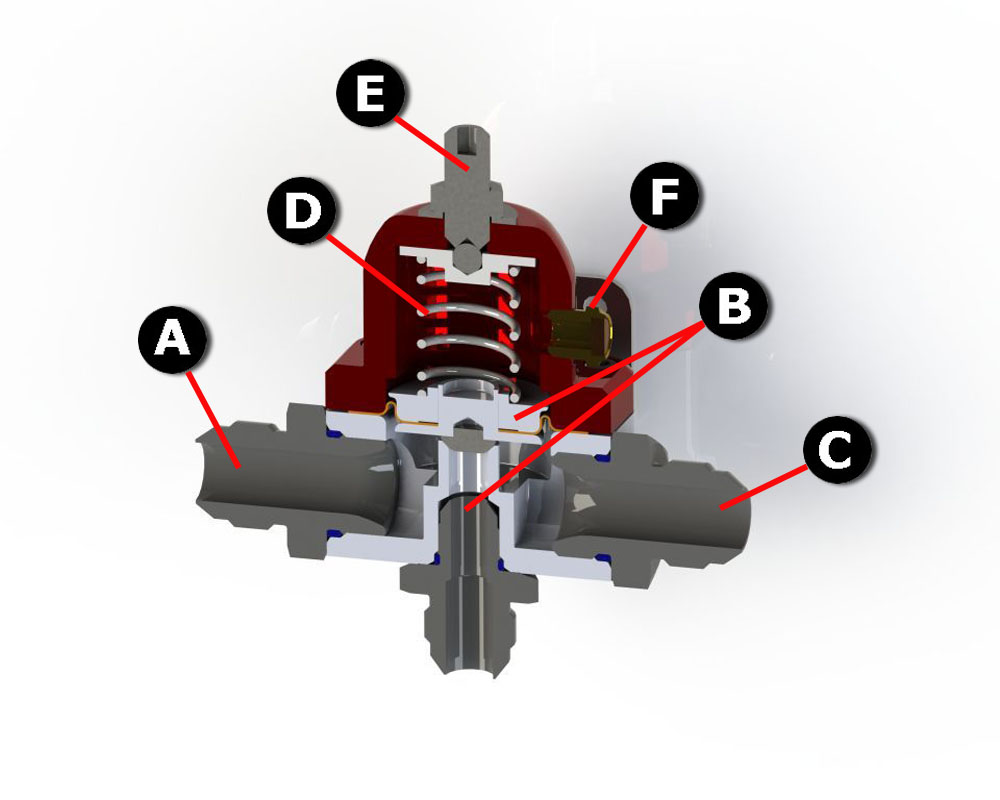Back in the day, low-pressure fuel delivery systems were the norm.
As carburetors evolved and fuel injection came into play, fuel pressures increased and low-pressure systems became common. However, low-pressure fuel systems remain relevant because many vintage cars use Weber or Stromberg carb setups. Aftermarket low-pressure pumps and regulators are also used to replace OE parts for better performance and reliability.
Companies like Fuelab offer a wide range of low-pressure fuel pressure regulators. The most common styles are blocking-style (also known as non-return) and return-style (also known as bypass-style), and Fuelab’s Jon Light offered a breakdown of each:
Non Return-Style Regulators (Blocking)
Design
Non-return style regulators are characterized by their lack of a fuel return line from the regulator back to the fuel tank. With a blocking style regulator, fuel enters through the inlet port (A), travels past the fuel control valve (B), and then is distributed through an outlet port to the carburetor. In this example, there are two outlet ports (C). Fuel flow and pressure are controlled by the fuel control valve that is actuated by a diaphragm (D). The diaphragm’s movement up and down is limited by a spring (E). Fuel pressure (psi) to the carburetor is set with a threaded adjustment mechanism (F). A vacuum/boost reference port allows the regulator to compensate for boost pressure with forced induction applications (G).
Advantages
- Requires no fuel return line and fittings from the regulator to the fuel tank. This reduces weight, complexity (routing a return line can prove to be difficult), and expense. It should be noted that a blocking style regulator does need an internal or external relief valve at the fuel pump, relieving bypassed fuel and pressure to the fuel tank.
- Multiple regulators (set at different pressures, such as with a nitrous oxide system application) may be used from one pump.
Disadvantages
- As fuel pressure reaches the maximum value to which the regulator has been set, the internal valve must shut off inlet pressure from getting to the outlet side of the valve. This action requires extra force (fuel pressure) to fully shut the valve off and creates a spike in fuel pressure as the valve reaches the closed position. The result is a slightly higher outlet pressure that could over-pressurize the carburetor and overfill the float bowls.
- In the closed position, leakage of the fuel control valve can cause fuel pressure to continue to build at the outlet. This is termed as “pressure creep.” This too can over-pressurize the carburetor and overfill the float bowls.
- The fuel control valve of blocking style regulators is more sensitive to debris that can keep it from completely closing, thereby causing pressure creep.
- Often, fuel pressure readings with the fuel control valve fully closed and the engine shut off (but with the fuel pump energized) can be inconsistent. In other words, the engine can be run and shut off multiple times, and pressure readings taken between each run/shut off cycle off can vary. For this reason, pressure adjustments for blocking-style regulators should be adjusted while the engine is idling, to keep a small amount of fuel always running through the regulator for greater consistency.
- It should be noted that blocking regulators may not be a good choice for blow-though forced induction systems as the inherent design of the fuel control valve can create a significant fuel pressure differentiation between the inlet and outlet (higher at the inlet, lower at the outlet). However, this issue applies to applications requiring high fuel flow and fuel pressure, and does not pose problems with the low flow/pressure applications covered by this article.
Return-Style Fuel Pressure Regulators (Bypass)
Design
Return, or bypass, style regulators are characterized by a fuel return line from the regulator back to the fuel tank. With a bypass style regulator, fuel enters through the inlet port (A) and travels past a fuel bypass valve/fuel return line port (which governs fuel flow and pressure) (B) and then is distributed through an outlet port to the carburetor (C). Opening and closing of the bypass valve is limited by a spring (D). Fuel pressure (psi) to the carburetor is set with a threaded adjustment mechanism (E). A vacuum/boost reference port allows the regulator to compensate for boost pressure with forced induction applications (F).
Advantages
- Constant, effective fuel pressure to the outlet port. Any pressure overage is bled off through the return port as needed.
- Constant, effective fuel pressure enables fuel pressure to be set more accurately and should remain constant regardless of load.
- Longer pump life and quieter pump operation. The pump operates just hard enough to maintain pressure, instead of maintaining typically 10 to 20 higher psi (blocking style regulators).
Disadvantages
- Added expense, complexity, and weight of additional fuel lines and fittings.
- The return line is very sensitive to pressure drop, especially with these very low pressure ranges. Large return lines, 1/2-inch or higher, must be used with limited bends and direct return to unpressurized tanks or reservoirs.
- Not applicable when multiple regulators need to be tied together and fed from one pump. The entire fuel system will be limited by the regulator with the lowest pressure setting, negating those set to higher pressures.
You can learn more about the operation and adjustment of each of these types of fuel pressure regulators here.
SOURCE: Fuelab



My fuel lines have pressure but fuel pressure regulator not pumping gas through to the carb
Can stuck bypass type regulator cause extremely low fuel rail pressrure as most of fuel is returning back to fuel tank and pump.
I have a 2.5L Z3 Roadster 1999 that was running okay. Set for week and then no start. Pump output from filter 80+ psi with gauge terminating fuel line momentarily but approx 10psi pressure at fuel rail lines connected. Should be near 50psi.